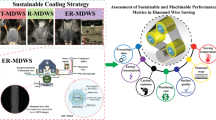Abstract
This work aims at selecting optimal operating variables to obtain the minimum specific energy (SE) in sawing of rocks. A particular granite was sampled and sawn by a fully automated circular diamond sawblades. The peripheral speed, the traverse speed, the cut depth and the flow rate of cooling fluid were selected as the operating variables. Taguchi approach was adopted as a statistical design of experimental technique for optimization studies. The results were evaluated based on the analysis of variance and signal-to-noise ratio (S/N ratio). Statistically significant operating variables and their percentage contribution to the process were also determined. Additionally, a statistical model was developed to demonstrate the relationship between SE and operating variables using regression analysis and the model was then verified. It was found that the optimal combination of operating variables for minimum SE is the peripheral speed of 25 m/s, the traverse speed of 70 cm/min, the cut depth of 2 cm and the flow rate of cooling fluid of 100 mL/s. The cut depth and traverse speed were statistically determined as the significant operating variables affecting the SE, respectively. Furthermore, the regression model results reveal that the predictive model has a high applicability for practical applications.
Similar content being viewed by others
References
BAYRAM F. Prediction of sawing performance based on index properties of rocks [J]. Arabian Journal of Geosciences, 2013, doi:10.1007/s12517-012-0668-5.
MIKAEIL R, ATAEI M, YOUSEFI R. Correlation of production rate of ornamental stone with rock brittleness indexes [J]. Arabian Journal of Geosciences, 2013, 6: 115–121.
XU X. Friction studies on the process in circular sawing of granites [J]. Tribology Letters, 1999, 7: 221–227.
KONSTANTY J. Theoretical analysis of stone sawing with diamonds [J]. Journal of Materials Processing Technology, 2002, 123: 146–154.
TONSHOFF HK, ILLMANN-APMANN H. Diamond tools for wire sawing metal components [J]. Diamond and Related Materials, 2002, 11(3/4/5/6): 742–74.
WEI X, WANG CY, ZHOU Z H. Study on the fuzzy ranking of granite sawability [J]. Journal of Materials Processing Technology, 2003, 139: 277–280.
DELGADO NS, RODRIGUEZ R, RIO A, SARRIA ID, CALLEJA L, ARGANDONA VGR. The influence of microhardness on the sawability of pink porrino granite (Spain) [J]. International Journal of Rock Mechanics and Mining Sciences, 2005, 42: 161–166.
ERSOY A, BUYUKSAGIS IS, ATICI U. Wear characteristics of circular diamond saws in the cutting of different hard and abrasive rocks [J]. Wear, 2005, 258: 1422–1436.
BUYUKSAGIS IS, GOKTAN RM. Investigation of marble machining performance using an instrumented block-cutter [J]. Journal of Materials Processing Technology, 2005, 169: 258–262.
KAHRAMAN S, ALTUN H, TEZEKICI BS, FENER M. Sawability prediction of carbonate rocks from shear strength parameters using artificial neural networks [J]. International Journal of Rock Mechanics and Mining Sciences, 2005, 43(1): 157–164
OZCELIK Y. The effect of marble textural characteristics on the sawing efficiency of diamond segmented frame saws [J]. Industrial Diamond Review, 2007, 2: 65–70.
BUYUKSAGIS IS. Effect of cutting mode on the sawability of granites using segmented circular diamond sawblade [J]. Journal of Materials Processing Technology, 2007, 183: 399–406.
KAHRAMAN S, ULKER U, DELIBALTA S. A quality classification of building stones from P-wave velocity and its application to stone cutting with gang saws [J]. The Journal of the Southern African Institute of Mining and Metallurgy, 2007, 107: 427–430.
MIKAEIL R, ATAEI M, HOSEINIE SH. Predicting the production rate of diamond wire saws in carbonate rocks cutting [J]. Industrial Diamond Review, 2008, 3: 28–34.
ATICI U, ERSOY A. Correlation of specific energy of cutting saws and drilling bits with rock brittleness and destruction energy [J]. Journal of Materials Processing Technology, 2009, 209: 2602–2612.
GUNEY A. Performance prediction of large-diameter circular saws based on surface hardness tests for Mugla (Turkey) marbles [J]. Rock Mechanics and Rock Engineering, 2011, 44: 357–366.
AYDIN G, KARAKURT I, AYDINER K. Development of predictive models for specific energy of circular diamond sawblades in sawing of granitic rocks [J]. Rock Mechanics and Rock Engineering, 2013, 46 (4): 767–783.
KARAKURT I, AYDIN G, AYDINER K. Experimental and statistical analysis of cutting force acting on diamond sawblade in sawing of granitic rocks [J]. Proc IMechE Part B: Journal of Engineering Manufacture, 2013, 227(2): 286–300.
KARAKURT I, AYDIN G, AYDINER K. Predictive modelling of noise level generated during sawing of rocks by circular diamond sawblades [J]. Sadhana-Academy Proceedings in Engineering Sciences, 2013, 38(3): 491–511.
AYDIN G, KARAKURT I, AYDINER K. Investigation of the surface roughness of rocks sawn by diamond sawblades [J]. International Journal of Rock Mechanics and Mining Sciences, 2013, 61: 171–182.
ISRM. Rock characterization Testing and Monitoring Suggested methods [M]. Oxford UK: Pergamon Press, 1981: 211.
ZOLFAGHARI G, ESMAILI-SARI A, ANBIA M, YOUNESI H, AMIRMAHMOODI S, GHAFARI-NAZARI A. Taguchi optimization approach for Pb(II) and Hg(II) removal from aqueous solutions using modified mesoporous carbon [J]. Journal of Hazardous Materials, 2011, 192: 1046–1055.
NOORYUSMIZA Y, RAMASAMY M, YUSUP S. Taguchi’s parametric design approach for the selection of optimization variables in a refrigerated gas plant [J]. Chemical Engineering Research & Design, 2011, 89: 665–675.
CHOU C S, YANG Y R, CHEN H J, HOU W S. The optimum conditions for preparing the lead-free piezoelectric ceramic of Bi0.5Na0.5TiO3 using the Taguchi method [J]. Powder Technology, 2010, 199: 264–271.
DONGXIA Y, HEDINGYONG L, HUANGHUI N. Optimization of weld bead geometry in laser welding with filler wire process using Taguchi’s approach [J]. Optics and Laser Technology, 2012, 44: 2020–2025.
Author information
Authors and Affiliations
Corresponding author
Rights and permissions
About this article
Cite this article
Karakurt, I. Specific energy optimization in sawing of rocks using Taguchi approach. J. Cent. South Univ. 21, 365–372 (2014). https://doi.org/10.1007/s11771-014-1949-9
Received:
Accepted:
Published:
Issue Date:
DOI: https://doi.org/10.1007/s11771-014-1949-9




